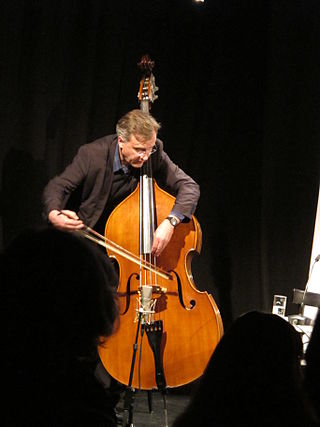Related Research Articles

In music, just intonation or pure intonation is the tuning of musical intervals as whole number ratios of frequencies. An interval tuned in this way is said to be pure, and is called a just interval. Just intervals consist of tones from a single harmonic series of an implied fundamental. For example, in the diagram, if the notes G3 and C4 are tuned as members of the harmonic series of the lowest C, their frequencies will be 3 and 4 times the fundamental frequency. The interval ratio between C4 and G3 is therefore 4:3, a just fourth.

In music theory, a comma is a very small interval, the difference resulting from tuning one note two different ways. Traditionally, there are two most common comma; the syntonic comma, "the difference between a just major 3rd and four just perfect 5ths less two octaves", and the Pythagorean comma, "the difference between twelve 5ths and seven octaves". The word comma used without qualification refers to the syntonic comma, which can be defined, for instance, as the difference between an F♯ tuned using the D-based Pythagorean tuning system, and another F♯ tuned using the D-based quarter-comma meantone tuning system. Intervals separated by the ratio 81:80 are considered the same note because the 12-note Western chromatic scale does not distinguish Pythagorean intervals from 5-limit intervals in its notation. Other intervals are considered commas because of the enharmonic equivalences of a tuning system. For example, in 53TET, B♭ and A♯ are both approximated by the same interval although they are a septimal kleisma apart.

Wilhelm Killmayer was a German composer of classical music, a conductor and an academic teacher of composition at the Hochschule für Musik und Theater München from 1973 to 1992. He composed symphonies and song cycles on poems by Friedrich Hölderlin, Joseph von Eichendorff, Georg Trakl and Peter Härtling, among others.

Toshio Hosokawa is a Japanese composer of contemporary classical music. He studied in Germany but returned to Japan, finding a personal style inspired by classical Japanese music and culture. He has composed operas, the oratorio Voiceless Voice in Hiroshima, and instrumental music.
Isabel Mundry is a German composer.

Heinrich Josef Konietzny was a German musician, professor and composer.
Marc Sabat is a Canadian composer based in Berlin, Germany, since 1999.
Helmut Oehring is a German composer. He was born in East-Berlin, the son of deaf parents. After training as a construction worker, Oehring worked as a cemetery gardener, forest worker, geriatric nurse and stoker. He is self-taught as guitarist and composer. From 1990 to 1992, Oehring studied with Friedrich Goldmann and Georg Katzer at the Academy of Arts, Berlin. He was a fellow of Villa Massimo in 1994/1995. Oering is honorary professor for Théatre musical at the University of the Arts Bern.
Max Beckschäfer is a German organist, composer and academic who taught at the Hochschule für Musik und Theater München and the Hochschule für Musik Augsburg-Nürnberg. He received commissions from the Munich Biennale, the concert series Klangspuren, the Dresdner Kreuzchor, the Palucca-Ballettschule Dresden and Die Singphoniker. He wrote an organ version of Reger's Hebbel-Requiem.

Jan Müller-Wieland is a German composer and conductor of classical music and an academic teacher. He is known for his operas.
Márton Illés, is a Hungarian composer and pianist.
Arnulf Herrmann is a German composer.
The Schneider-Schott Music Prize is a cash award bestowed to an outstanding composer, performing artist, or music ensemble in classical music—with emphasis, but not mandatory, on contemporary music. From 1986 to 2006, the prize was awarded annually, and thereafter, biennially. The prize is alternately given to a composer and an interpreter. The award ceremony is traditionally associated with a concert by the award winner.
Lin Wang, is a Chinese composer. Lin Wang was born in Dalian, China, in 1976.

Gordon Kampe is a German composer and academic teacher.

Dieter Rexroth was a German musicologist, dramaturge and cultural manager. He was intendant of the Deutsches Symphonie-Orchester Berlin from 1996, responsible also for choirs and orchestras in Berlin. He worked for major festivals including Frankfurter Feste at the Alte Oper, Young Euro Classic in Berlin and the Kasseler Musiktage. He wrote or edited books about composers including Paul Hindemith, Hans Werner Henze and Wolfgang Rihm.
Diether de la Motte was a German musician, composer, music theorist, music critic and academic teacher.

Klaus Hinrich Stahmer is a German composer and musicologist. He gave added to the development of music in the 1980s through multimedia works, including music with sound art sculptures and musical graphic). He also broke new artistic ground with his compositions for non-European instruments, which can be classified as world music.
Birke Jasmin Bertelsmeier is a German composer.
References
- ↑ List of award winners, Villa Massimo.
- ↑ Archive notes to second biennale, 1990, Munich Biennale.
- 1 2 "Wolfgang von Schweinitz". CalArts. 7 February 1953. Retrieved 9 December 2024.
- ↑ "Wolfgang von Schweinitz Bio 2008". www.plainsound.org. Retrieved 2019-03-18.
- ↑ Sabat, Marc (2005). "The Extended Helmholtz-Ellis JI Pitch Notation" (PDF).
- ↑ "Schneider-Schott-Musikpreis". Landeshauptstadt Mainz (in German). 12 October 2018. Retrieved 9 December 2024.
- ↑ "SHMF Liste der Preisträger: Paul Hindemith". Startseite (in German). Retrieved 9 December 2024.